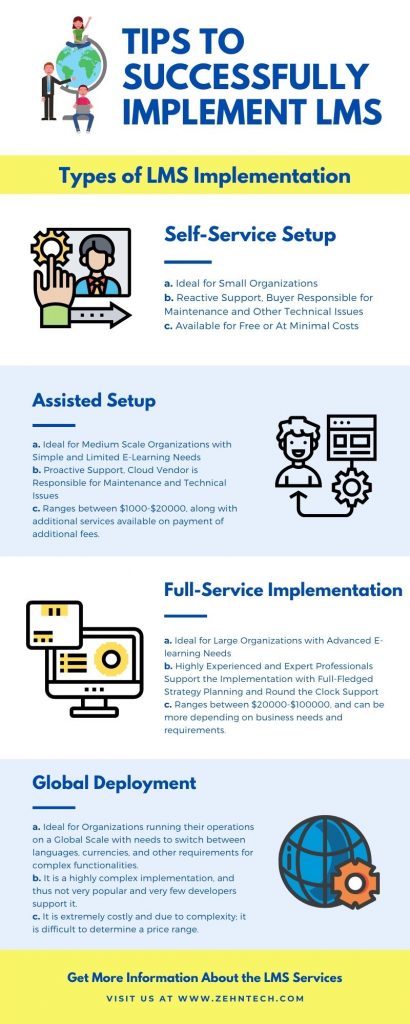With an ever-increasing number of students preferring e-learning to classroom learning, higher number of organizations finding a competitive advantage and revenue growth with the use of learning management systems and e-learning, it is obvious that the businesses are keen on learning management system implementation.
The e-learning industry is fast-growing and is predicted to become a $300million market by 2021. With that, no organization wants to leave out on the chance to leverage this market and they are actively looking for ways in which they can successfully implement an LMS for their operational systems.
This article describes four successful ways for LMS implementation. Each way follows a different approach and is preferrable for its own reasons. You need to figure out what will suit your business and strategy the best and choose accordingly.
Let’s move on to the LMS Implementation Types.
Types of LMS Implementation
Self Service Setup
These are the simplest for of LMS implementation systems. Cloud Computing Technology is in the vogue and with that SaaS application development has taken tremendous pace. Self-Service LMS Implementations make use of this technology. Since the LMS is on a SaaS based cloud application, it is already implemented and the user only has to configure the system. Once done, the user can start benefitting from the available courses and modules over the LMS.
The user can take it on a trial basis. Generally, a 30-days trial is period is made available by the cloud vendors. After this trial, the users can decide if they want to continue with the LMS or not. If they are willing, they can go in for monthly or yearly subscription.
This comes in as a convenient and comfortable way and is best suited for the ones with basic and minimal needs for a learning management system.
Assisted Setup
This is more or less similar to the self-service setup, except that here there is an ongoing proactive support from the cloud vendor providing the LMS implementation. In the self-service setup, the support is provided only when the customer asks for it. However, in the assisted setup, while the customer keeps using the LMS over the cloud platform, the cloud vendor provides support and maintenance for the LMS, advising on critical decisions and other technical stuff.
With such support it is easier for the organizations to focus on the learning part and better leverage the LMS. The form of implementation suits the businesses with very clear, straightforward, and limited e-learning needs and requirements.
Full Service LMS Implementation
This way of LMS implementation has been in practice ever since the advent of e-learning and learning management systems and it still stands to be the most preferred form of LMS implementation among businesses. In fact, if you are an organization with vast and complicated LMS needs and requirements, you must go for this setup.
This setup involves experienced and expert LMS implementation professionals at your service who prepare and plan a full-fledged learning management implementation strategy and guide you through the entire process. Additionally, they provide proactive support for the LMS so that you can have the best experience from it with great content management and learning.
A place for big ideas.
Reimagine organizational performance while delivering a delightful experience through optimized operations.


Global Deployment
This kind of LMS implementation is highly complex and goes beyond mere e-learning. It involves complex integrations, customizations, business process redesigning, talent management, e-commerce integration and support, and a lot more which makes these systems extremely difficult and costly to implement. Additionally, due to the complexity and technicalities involved in the implementation, only a handful of developers work on the global deployment and implementation of learning management systems.

Conclusion
However, despite the complexity, these systems work extremely well for the organizations with their business spread globally and high needs for e-learning solutions.
So, these are the four different ways in which you can carry out a learning management system implementation. The implementation highly depends on your business needs and requirements as well as the costs you are willing to incur. So, you need to analyze thoroughly and then take the decision.











